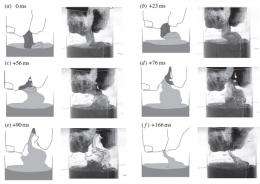May 26, 2011 report
Cats versus dogs in the 'drinking' category (w/ video)

(PhysOrg.com) -- The competition between cat and dog owners has one or the other always looking for an advantage and cat owners thought they had one last year when Pedro Reis and Roman Stocker from MIT discovered that cats used their tongues in a very unique way to dry water into their mouths. While cats drank in this manner, Reis was sure that dogs, which are known for scooping and making a mess, had to drink in a different way.
However, A. W. Crompton and Catherine Musinsky from Harvard University decided they needed to step up on the side of the dogs and discover just how they drink water. In a new study published in Biology Letters, Crompton and Musinsky show that dogs drink in the same fashion as cats, leaving to a draw in the competition. Cats however may win the point for being less messy when they drink.
Similar to the study done by Reis and Stocker on cats, Crompton and Musinsky used high-speed video and x-ray video to show just what happens when a dog drinks water. While most people assume that the dog, which curves its tongue to form a spoon of sorts, scoops water into its mouth, this is actually inaccurate. While the dog does scoop its tongue, the water that is trapped in the ‘scoop’ is actually lost when the dog draws its tongue into its mouth.
Similar to a cat, the dog’s tongue actually draws a column of water up to the mouth when the tongue is lifted. Before the column is disrupted, the dog closes its mouth. Once the water is in the mouth, the tongue presses against the roof of the mouth and traps the water until another column is drawn in with the next lap. It takes an average three laps before water is pushed back into the throat for the dog to drink.
More information: How dogs lap: ingestion and intraoral transport in Canis familiaris, Biology Letters, Published online before print May 25, 2011, doi:10.1098/rsbl.2011.0336
Abstract
It has recently been suggested that the mechanism for lifting liquid from a bowl into the oral cavity during lapping is fundamentally different in cats and dogs: cats use adhesion of liquid to the tongue tip while dogs ‘scoop’ with their backwardly curled tongue. High-speed light videos and X-ray videos show that on the contrary, both cats and dogs use the mechanism of adhesion. Liquid is transported through the oral cavity to the oesophagus, against gravity, on the surface of the tongue as it is drawn upwards, then a tight contact between the tongue surface and palatal rugae traps liquid and prevents its falling out as the tongue is protruded. At least three cycles are needed for intraoral transport of liquid in the dog.
© 2010 PhysOrg.com
















